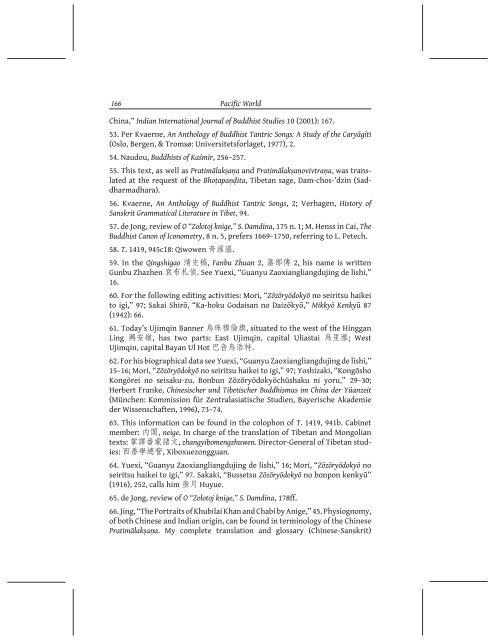download - The Institute of Buddhist Studies
download - The Institute of Buddhist Studies
download - The Institute of Buddhist Studies
Create successful ePaper yourself
Turn your PDF publications into a flip-book with our unique Google optimized e-Paper software.
166<br />
Pacific World<br />
China,” Indian International Journal <strong>of</strong> <strong>Buddhist</strong> <strong>Studies</strong> 10 (2001): 167.<br />
53. Per Kvaerne, An Anthology <strong>of</strong> <strong>Buddhist</strong> Tantric Songs: A Study <strong>of</strong> the Caryāgīti<br />
(Oslo, Bergen, & Tromsø: Universitetsforlaget, 1977), 2.<br />
54. Naudou, <strong>Buddhist</strong>s <strong>of</strong> Kaśmīr, 256–257.<br />
55. This text, as well as Pratimālakṣaṇa and Pratimālakṣaṇovivtraṇa, was translated<br />
at the request <strong>of</strong> the Bhoṭapaṇḍita, Tibetan sage, Dam-chos-’dzin (Saddharmadhara).<br />
56. Kvaerne, An Anthology <strong>of</strong> <strong>Buddhist</strong> Tantric Songs, 2; Verhagen, History <strong>of</strong><br />
Sanskrit Grammatical Literature in Tibet, 94.<br />
57. de Jong, review <strong>of</strong> O “Zolotoj knige,” S. Damdina, 175 n. 1; M. Henss in Cai, <strong>The</strong><br />
<strong>Buddhist</strong> Canon <strong>of</strong> Iconometry, 8 n. 5, prefers 1669–1750, referring to L. Petech.<br />
58. T. 1419, 945c18: Qiwowen 奇 渥 溫 .<br />
59. In the Qingshigao 清 史 稿 , Fanbu Zhuan 2, 藩 部 傳 2, his name is written<br />
Gunbu Zhazhen 袞 布 札 偵 . See Yuexi, “Guanyu Zaoxiangliangdujing de lishi,”<br />
16.<br />
60. For the following editing activities: Mori, “Zōzōryōdokyō no seiritsu haikei<br />
to igi,” 97; Sakai Shirō, “Ka-hoku Godaisan no Daizōkyō,” Mikkyō Kenkyū 87<br />
(1942): 66.<br />
61. Today’s Ujimqin Banner 烏 珠 穆 倫 旗 , situated to the west <strong>of</strong> the Hinggan<br />
Ling 興 安 嶺 , has two parts: East Ujimqin, capital Uliastai 烏 里 雅 ; West<br />
Ujimqin, capital Bayan Ul Hot 巴 音 烏 浩 特 .<br />
62. For his biographical data see Yuexi, “Guanyu Zaoxiangliangdujing de lishi,”<br />
15–16; Mori, “Zōzōryōdokyō no seiritsu haikei to igi,” 97; Yoshizaki, “Kongōsho<br />
Kongōrei no seisaku-zu. Bonbun Zōzōryōdokyōchūshaku ni yoru,” 29–30;<br />
Herbert Franke, Chinesischer und Tibetischer Buddhismus im China der Yüanzeit<br />
(München: Kommission für Zentralasiatische Studien, Bayerische Akademie<br />
der Wissenschaften, 1996), 73–74.<br />
63. This information can be found in the colophon <strong>of</strong> T. 1419, 941b. Cabinet<br />
member: 内 閣 , neige. In charge <strong>of</strong> the translation <strong>of</strong> Tibetan and Mongolian<br />
texts: 掌 譯 番 蒙 諸 文 , zhangyibomengzhuwen. Director-General <strong>of</strong> Tibetan studies:<br />
西 番 學 總 管 , Xiboxuezongguan.<br />
64. Yuexi, “Guanyu Zaoxiangliangdujing de lishi,” 16; Mori, “Zōzōryōdokyō no<br />
seiritsu haikei to igi,” 97. Sakaki, “Bussetsu Zōzōryōdokyō no bonpon kenkyū”<br />
(1916), 252, calls him 壺 月 Huyue.<br />
65. de Jong, review <strong>of</strong> O “Zolotoj knige,” S. Damdina, 178ff.<br />
66. Jing, “<strong>The</strong> Portraits <strong>of</strong> Khubilai Khan and Chabi by Anige,” 45. Physiognomy,<br />
<strong>of</strong> both Chinese and Indian origin, can be found in terminology <strong>of</strong> the Chinese<br />
Pratimālakṣaṇa. My complete translation and glossary (Chinese-Sanskrit)
















